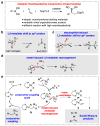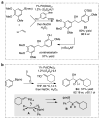Catalytic conjunctive cross-coupling enabled by metal-induced metallate rearrangement
- PMID: 26721996
- PMCID: PMC5510870
- DOI: 10.1126/science.aad6080
Catalytic conjunctive cross-coupling enabled by metal-induced metallate rearrangement
Abstract
Transition metal catalysis plays a central role in contemporary organic synthesis. Considering the tremendously broad array of transition metal-catalyzed transformations, it is remarkable that the underlying elementary reaction steps are relatively few in number. Here, we describe an alternative to the organometallic transmetallation step that is common in many metal-catalyzed reactions, such as Suzuki-Miyaura coupling. Specifically, we demonstrate that vinyl boronic ester ate complexes, prepared by combining organoboronates and organolithium reagents, engage in palladium-induced metallate rearrangement wherein 1,2-migration of an alkyl or aryl group from boron to the vinyl α-carbon occurs concomitantly with C-Pd σ-bond formation. This elementary reaction enables a powerful cross-coupling reaction in which a chiral Pd catalyst merges three simple starting materials-an organolithium, an organoboronic ester, and an organotriflate-into chiral organoboronic esters with high enantioselectivity.
Copyright © 2016, American Association for the Advancement of Science.
Figures




Comment in
-
ORGANIC CHEMISTRY. When two reactions become one.Science. 2016 Jan 1;351(6268):26-7. doi: 10.1126/science.aad8698. Science. 2016. PMID: 26721989 No abstract available.
References
-
- Hall DG, editor. Boronic Acids. Wiley-VHC; Weinheim: 2011.
-
- Miyaura N, Yamada K, Suzuki A. Tetrahedron Lett. 1979;20:3437–3440.
-
- Miyaura N, Suzuki A. Chem Rev. 1995;95:2457–2483.
-
- Jia T, Cao P, Wang B, Lou Y, Yin X, Wang M, Liao J. J Am Chem Soc. 2015;137:13760–13763. - PubMed
-
- Su W, et al. Angew Chem Int Ed. 2015;54:12957–12961. - PubMed
Publication types
MeSH terms
Substances
Grants and funding
LinkOut - more resources
Full Text Sources
Other Literature Sources
Research Materials

